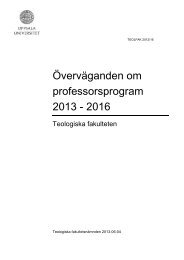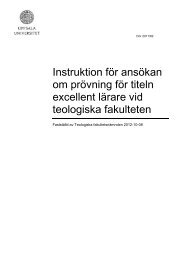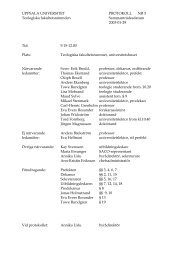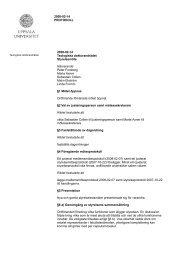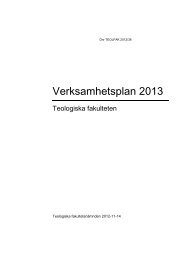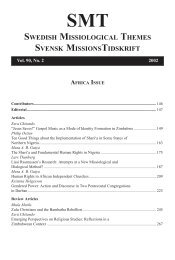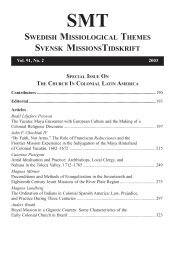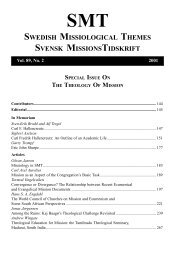SWEDISH MISSIOLOGICAL THEMES SVENSK MISSIONSTIDSKRIFT
SWEDISH MISSIOLOGICAL THEMES SVENSK MISSIONSTIDSKRIFT
SWEDISH MISSIOLOGICAL THEMES SVENSK MISSIONSTIDSKRIFT
You also want an ePaper? Increase the reach of your titles
YUMPU automatically turns print PDFs into web optimized ePapers that Google loves.
482 Tormod Engelsviken<br />
different ways share their faith with others. 3 This seems to happen especially<br />
when the church grows through popular movements or revivals. The gospel<br />
of Christ most likely reached the largest cities in the Roman Empire: Rome,<br />
Alexandria and Antioch, through such “ordinary” Christians who shared<br />
their faith through words and demonstrated it by their lives. We do not<br />
know any apostles or other ecclesiastical envoys who brought the gospel<br />
for the first time to these cities (cp. Acts 11:19-21). The same would apply<br />
to the areas surrounding the major cities that Paul visited on his missionary<br />
journeys and most of the rural areas.<br />
Down through the history these “anonymous Christians” have played a<br />
major role in the mission of the church. 4 It would not be, however,<br />
appropriate to call them “missionaries”. This may be a parallel to the saying<br />
that all Christians are priests (“Priester”) but not all are “pastors”<br />
(“Pfarrer”). All Christian are called to mission, but not all to become<br />
missionaries. This distinction might in a biblical perspective correspond<br />
with the fact that all Christians have received the Spirit of God, all belong<br />
to the same body, yet they are different members with various gifts and<br />
ministries (1 Cor. 12-14; Rom 12:4-8).<br />
Without disparaging the importance of the mission of the whole church, we<br />
would in this article only call those “missionaries” whom Bill Taylor in the<br />
Evangelical Dictionary of World Missions describes in the following way.<br />
“These men and women are cross-cultural workers who serve within or<br />
without their national boundaries, and they will cross some kind of linguistic,<br />
cultural, or geographic barriers as authorised sent ones.” 5 Admittedly, there<br />
is a flaw in defining missionaries as “cross-cultural workers” because it<br />
excludes those who labour within their own culture to reach people with the<br />
3 Sundkler/Steed expresses this with a view to the growth of Christianity in North-East-<br />
Africa: “Christianity spread via the Red Sea as it had done in the Mediterranean: by Christian<br />
traders bringing their goods and their witness”, Sundkler/Steed 2000:36. To the debate<br />
whether Christianity during the first century A.D. spread primarily through organised<br />
planned mission or by “microcommunication”, by “private und berufliche Kontakte, Faceto-Face<br />
Kommunikation in Primär- und Quasiprimärgruppen”, see Reinbold 2000 and<br />
Stenschke 2003:8-10.<br />
4 See for example the emphasis placed on this by Sundkler/Steed in their whole approach<br />
to African church history, Sundkler/Steed 2000:81-91, where three categories are especially<br />
mentioned: kings and chiefs, the young men, the slaves and other socially marginalised<br />
groups.<br />
5 Moreau 2000:645



